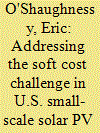|
|
|
Sort Order |
|
|
|
Items / Page
|
|
|
|
|
|
|
| Srl | Item |
| 1 |
ID:
169716


|
|
|
|
|
| Summary/Abstract |
Solar photovoltaic (PV) prices have fallen significantly over the past two decades. These price reductions have relied primarily on falling system hardware costs. Future reductions in PV prices—which are needed to ensure that enough PV will be deployed to meet global clean energy objectives—will require reductions in non-hardware or “soft” costs, particularly in markets with relatively high soft costs such as the United States. In this article, we draw insights from the literature on which factors affect soft costs for small-scale PV systems in the United States. The literature shows that soft costs tend to be lower for systems that are larger, installed during new construction, installed by more experienced installers, installed in more concentrated markets and in more competitive markets, installed in markets where customers receive more quotes, or installed in markets with less onerous permitting requirements. We identify three marketplace design strategies that policymakers could pursue to address the soft cost challenge in the United States and similar markets: encourage the expansion of quote platforms; encourage or require that PV system installation be integrated into the new construction and roof replacement process; and encourage the expansion of customer aggregation models such as Solarize campaigns and community solar.
|
|
|
|
|
|
|
|
|
|
|
|
|
|
|
|
| 2 |
ID:
183097


|
|
|
|
|
| Summary/Abstract |
Most rooftop solar photovoltaic (PV) systems must be reviewed and approved by local governments and electric service providers prior to operation. These permitting, inspection, and interconnection (PII) requirements help ensure safe PV system installation and operation, but onerous requirements may needlessly delay construction and operation. Here, we analyze PV PII data to understand the effects of local PII requirements on PV process durations. We combine data on local PII requirements with estimates of process durations for 248,741 PV systems installed in the United States. The data show that local variations in PII requirements can partly explain variations in PV process durations. Requirements that would be expected to reduce durations—such as instant online approvals—are generally associated with shorter durations, while requirements that would be expected to increase durations—such as structural reviews—are associated with longer durations. We find only weak evidence that measures to expedite pre-install processes result in post-install delays, and similarly find only weak evidence that increased pre-install PII oversight can save time in post-install stages. Our results provide further rationale for PII authorities to analyze their requirements and identify opportunities to streamline PII processes.
|
|
|
|
|
|
|
|
|
|
|
|
|
|
|
|
| 3 |
ID:
166955


|
|
|
|
|
| Summary/Abstract |
Community choice aggregation (CCA) is an emerging model of energy procurement that allows local governmental entities to procure electricity on behalf of retail electricity customers. Through CCA, local governments can control local electricity portfolios while investor-owned utilities remain responsible for transmission and distribution. In this article, we use a combination of publicly-available data, data obtained directly from CCAs, and stakeholder interviews to explore the rise of CCAs, the current and potential future impacts of CCAs on demand for renewable energy, and the factors that will determine future CCA expansion. We estimate that CCAs procured about 42 million megawatt-hours of electricity on behalf of about 5 million customers in the United States in 2017. We estimate that CCAs already procure about 8.9 million megawatt-hours more renewable energy than required by state mandates, and that CCAs could procure as much as 28.9 million megawatt-hours of voluntary renewable energy if the CCA model is permitted in more states. The ongoing expansion of CCAs could significantly affect electricity markets, electricity portfolios, and the future role of utilities. We explore various challenges associated with the further expansion of CCAs.
|
|
|
|
|
|
|
|
|
|
|
|
|
|
|
|
| 4 |
ID:
176867


|
|
|
|
|
| Summary/Abstract |
Local permitting can ensure the safe installation and operation of rooftop solar photovoltaic (PV) systems. At the same time, burdensome local permitting processes and local variation in requirements may pose challenges to PV deployment. In this article, we explore new data on the durations between key steps in the PV permitting process in the United States. The data suggest that a typical customer can expect to wait around 25–100 days from permit application until an installed system passes inspection. Permit durations vary significantly across jurisdictions, due in part to differences in local permitting policies. However, permit durations vary as significantly within jurisdictions as across them, in part due to significant variation across installers, suggesting that installer strategies and practices play an important role in permitting timelines. Permit durations have declined over time, reflecting progress from permit streamlining policies and jurisdiction learning-by-doing, though durations have stabilized in recent years. The data suggest that typical PV customers still face long and uncertain permitting timelines in the United States.
|
|
|
|
|
|
|
|
|
|
|
|
|
|
|
|
| 5 |
ID:
183621


|
|
|
|
|
| Summary/Abstract |
Financial incentives for rooftop solar photovoltaic (PV) adoption have declined in the United States over time by policy design. Incentive phase-down can efficiently promote early adoption and avoid ineffective payments to late adopters. However, incentive phase-down may exclude low- and moderate-income (LMI) households from realizing the same financial benefits from PV adoption as high-income early adopters. Here, data from two state-level LMI PV incentive programs are analyzed to test whether incentives still drive PV adoption among LMI households. As a first order approximation, the analysis suggests that incentives drove adoption that would not otherwise have happened in about 80% of cases. To the extent that policymakers prioritize PV adoption equity as part of the emerging energy justice policy agenda, the results suggest that ongoing incentive support for LMI adoption may be merited.
|
|
|
|
|
|
|
|
|
|
|
|
|
|
|
|
|
|
|
|
|